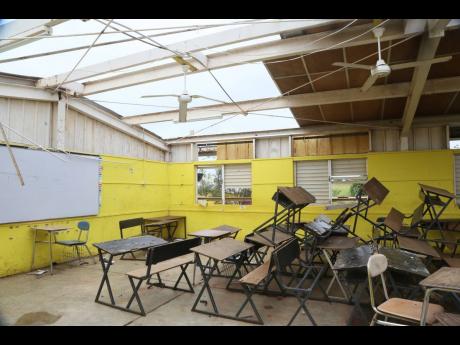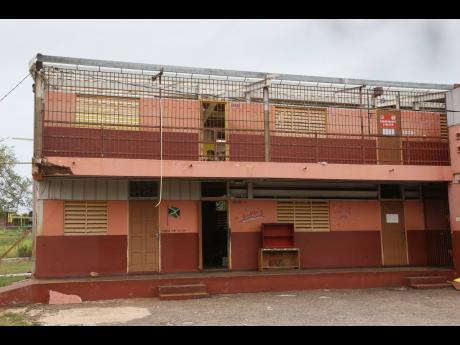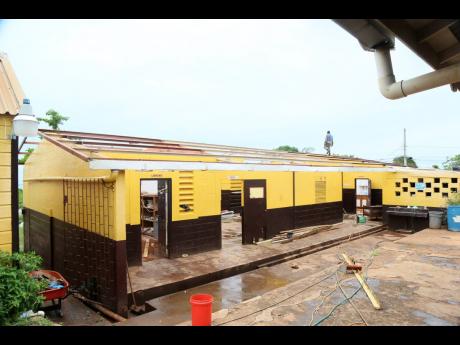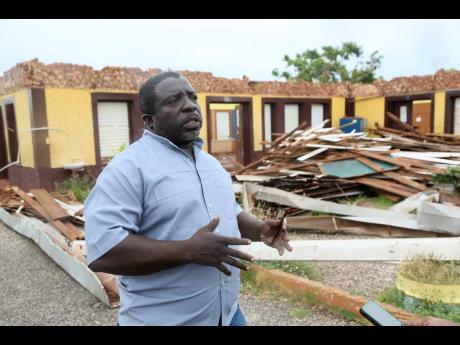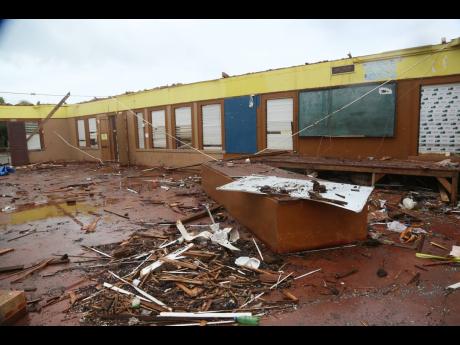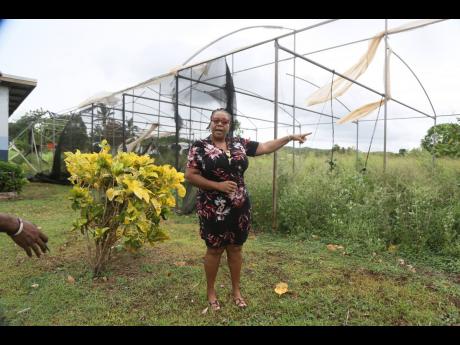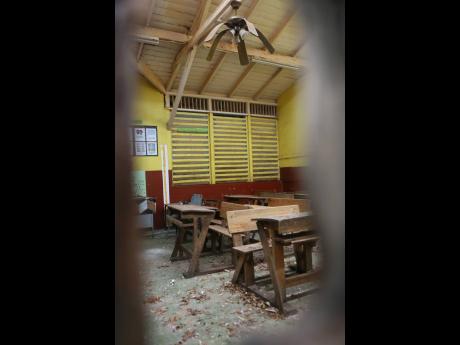RACE AGAINST TIME
With roofless classrooms a week before reopening, daunting repairs bring back-to-school blues
They started their formal education with lockdowns and online schooling as COVID-19 pummelled the education system four years ago. Now, as they enter their final primary school years, they face another daunting setback in the wake of Hurricane...
They started their formal education with lockdowns and online schooling as COVID-19 pummelled the education system four years ago. Now, as they enter their final primary school years, they face another daunting setback in the wake of Hurricane Beryl.
The images are starkly different from those at primary schools in the Corporate Area, which, for the most part, were seemingly physically ready for the new school year, which starts next week. St Elizabeth and Manchester, however, were the hardest hit by the Category 4 storm, and the state of some primary schools, particularly their grades five and six classrooms, remain a chilling testament to the events that unfolded.
Most of the roofless grades five and six classrooms at four primary schools visited by The Sunday Gleaner last Friday were located on the second floor of the mostly old and termite-infested buildings; and even if their roofs were replaced, some of them still may not be structurally sound to accommodate classes.
Among the hardest hit is the Bull Savannah Primary School in St Elizabeth, where the roof of an old building used for grades five and six classrooms was ripped off by the hurricane’s strong winds, inviting the torrents of rainfall that drenched furniture, electronic gadgets, and hundreds of books, some of which are irreplaceable.
The roofs of the grades one to four classrooms were also damaged, and Principal Colin Cameron explained that while those may be repaired by the second week of September, the damage to the other classrooms – and a canteen found to be structurally unsafe – will take a much longer time. He estimates that it may take upwards of $50 million for the total restoration, $25 million of which is being pledged by the ARC Group.
After that, clean-up activities may take a bit longer, affecting some 340 students, who will see parts of their school cordoned off to prevent injury, Cameron told The Sunday Gleaner.
“In this building (grades five and six), a large portion of the roof went, but what happened is that after we assessed the situation, we found out that termites had infested all the boards and rafters in this area. So we had to pull down everything, and the plan now is to put up steel beams,” said Cameron, who himself was involved in the heavy lifting at the school on Friday.
“These are our largest classrooms, and also a place where we had a lot of our community meetings ... . Most of the classrooms – except five and six – should have the roof on by Monday or Tuesday. The windows are being manufactured and may come a little later,” he said, scratching his head as he noted that alternative arrangements will have to be made for the higher grades.
Most important group
“My job, at this point in time, is to look at how best to get the school started while I figure out the rest. Grade six is the most important group because they are the exit group,” he said, noting that students only have until December to finish the primary school curriculum before their Primary Exit Profile (PEP) tests.
“The exam starts in February, and January going down is just building on that work. Grade six is the priority, so they may have access to the rooms where, for example, a grade two would have been.”
The storm also damaged the school’s Internet and CCTV set-up, which will also have to be restored, along with the canteen building, a temporary area for which will be set up elsewhere on the compound.
A basic school also located on the compound did not suffer significant damage, the principal assured parents.
In April, Education Minister Fayval Williams announced that a new school building would be constructed at Burnt Savannah Primary as the century-old wooden structure was infested with termites.
She said the new structure would ensure that students have more space and access to up-to-date technology.
Several classrooms at Top Hill Primary School, also in St Elizabeth, were torn off in the hurricane.
On Friday, Principal Cavene Headlam carefully navigated puddles to display drenched books, their pages twisting over each other, in the school’s library. She skipped between damaged furniture in a grade six classroom with no roof; and will have to find alternative spaces for the school’s canteen, which was also infested with termites.
Drenched books
“We lost all the books in the library, all the books in the fourth grade. We have lost quite a few desks, but the chairs are still here ... . The makeshift whiteboards that we would normally use have come down as well,” she detailed. “Many of the grades five and six students were the grade ones when COVID-19 struck, and they were at home for approximately two years. So we would want them back here comfortably in time for their exams. And the online thing doesn’t work for us here.”
Muriel Johnson, principal secretary at the New Forest High School in Manchester, explained that it will take millions of dollars to restore a greenhouse and a goat farm that were severely thrashed by the storm. The high school sustained damage, but not as much as the New Forest Primary School, whose grade six roof was badly damaged.
“I know that they will have some serious challenges,” offered Johnson, reflecting on the badly damaged roofs at the school.
At the Huntley Primary and Infant School in Mandeville, it was a similar tale of woe.
“We lost the books in the library, we lost a television; the roof went so the water came in. So we lost whiteboards and, of course, the plumbing system because the drums went down and the pipes along with it,” offered a female representative. “The grade six classroom is the one that went. It sustained the most damage [to] the roof, so anything that was in there would be wet.”
School, she said, will open with psychosocial activities for the children, many of whom would have lost their homes and may have been left traumatised by the passing of the storm.
“The roofing will be finished by the 28th of August for us to come in and clean up and the Ministry of Education [requested] a list of the furniture needed, so I guess they will help us with the furniture,” she said.
In the meantime, workmen hammered away last Friday at a roof at the Pedro Plains Primary School in St Elizabeth, which was ransacked by the storm. That building was said to house a library and offices. Half of the roof of the second-floor grade six classroom was completely missing with the clock ticking away to the commencement of the school year.
HUNDREDS OF SCHOOLS DAMAGED
A week after the passage of the hurricane, the Ministry of Education noted that preliminary assessments had found that 212 of the island’s 1,009 public schools had suffered damage. The number was later revised to 352 with repairs estimated at some $2.7 billion.
The ministry said the technical skills of quality surveyors are to be utilised to assess rehabilitation works that are now being carried out to retrofit 107 of the 352 schools that were significantly damaged. These institutions have been placed in Priorty One.
The other 245 schools, which also sustained damage of varying degrees, have been placed in Priorities Two and Priority Three, with more than 100 in each category. They are to be repaired over an extended time frame while schools are in operation.
Roof repairs have been completed at several schools across the island, including Unity Primary in Westmoreland; St Christopher’s School for the Deaf in St Ann; Richmond Park Primary in Mocho, Clarendon.
By mid-August, all classroom roofs at the St Hilda’s Diocesan High in Brown’s Town, St Ann, had been repaired and work was being wrapped up on the dormitories with the main building next to be given attention.
Despite the progress, the Jamaica Teachers’ Association (JTA) and the opposition People’s National Party have expressed concerns about the pace of the repairs with the new school year fast approaching.
But addressing the JTA’s Annual Conference in Trelawny last week, Williams sought to calm fears, indicating that there are plans for institutions that have not been fully repaired.
“We have been meeting with our regional directors, with all our building officers, and if there’s a situation that they believe may not be totally ready for September 2, they’ve already put contingency plans in place, which have been discussed with principals,” the minister told the educators.
“There are not too many of those situations, but I could think of one school in which the timber building that they were using is collapsed, and it is impossible to put up a replacement building in eight weeks. That regional director has already had conversations with the principal, with parents, and [with] a church that has a hall that’s right across the street to accommodate those students. So when I talk about contingency plans, that’s an example of what would allow schools to carry on,” the minister added.
Williams acknowledged that Munro College, one of the St Elizabeth schools pounded by the hurricane, could be opened a week late based on the scale of repairs needed.
And although further noting that the hurricane expedited work “that needed to have been done decades ago”, she said there would still be a need for significant infrastructural work in the future.
“Some roofs that used to leak will leak no more because they have been replaced as a result of the work that we did to rectify the hurricane damage, but I don’t want to depend on a hurricane to do what we ought to be doing in and out of season,” Williams said.
FAMILIES STRUGGLING
In the meantime, Ornella Lewis, parish disaster coordinator at the St Elizabeth Municipal Corporation, said several schools are likely to still need significant repairs when the new academic year starts.
“Even some of the schools that are not used as shelters, it will be very difficult for some of them to be fully up and running by September based on the scope of work that you can see needs to be done,” she told The Sunday Gleaner.
Lewis further noted that families could struggle with back-to-school preparations as many, particularly those in the coastal fishing communities, have lost their livelihoods in addition to sustaining significant damage to their homes even as sections of the parish remain without power.
“What we really wanted to do is get an assessment from the residential aspect, a little over 3,000 homes and counting, and in some instances, there is extreme devastation,” she said.
“So some of the families that we have met with, their homes will either have to be repaired or replaced altogether, so they will be affected long term,” she continued, noting the complaints by residents regarding the long waits for grants from the Government.
For now, various foundations, and corporate entities have been putting on a series of treats across the parishes, and at some schools, past students and parents have been rallying to help each other get back to normal.


